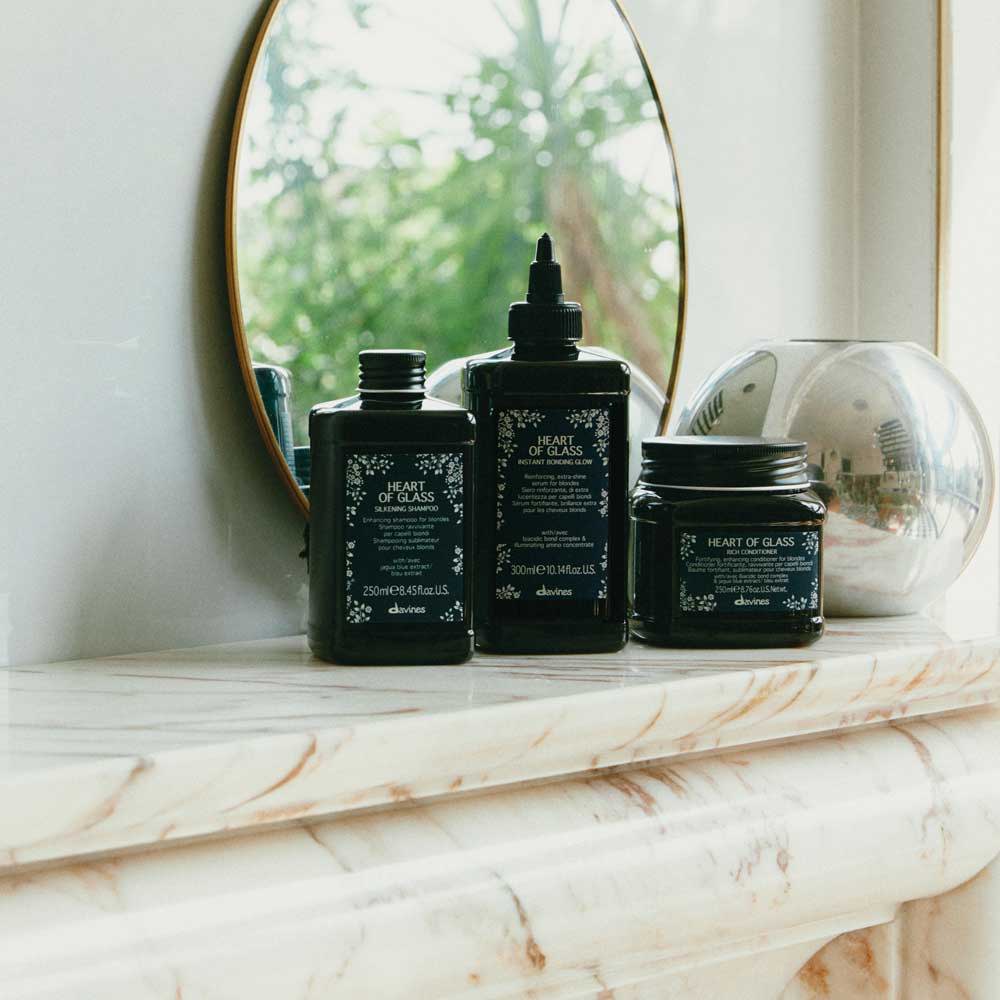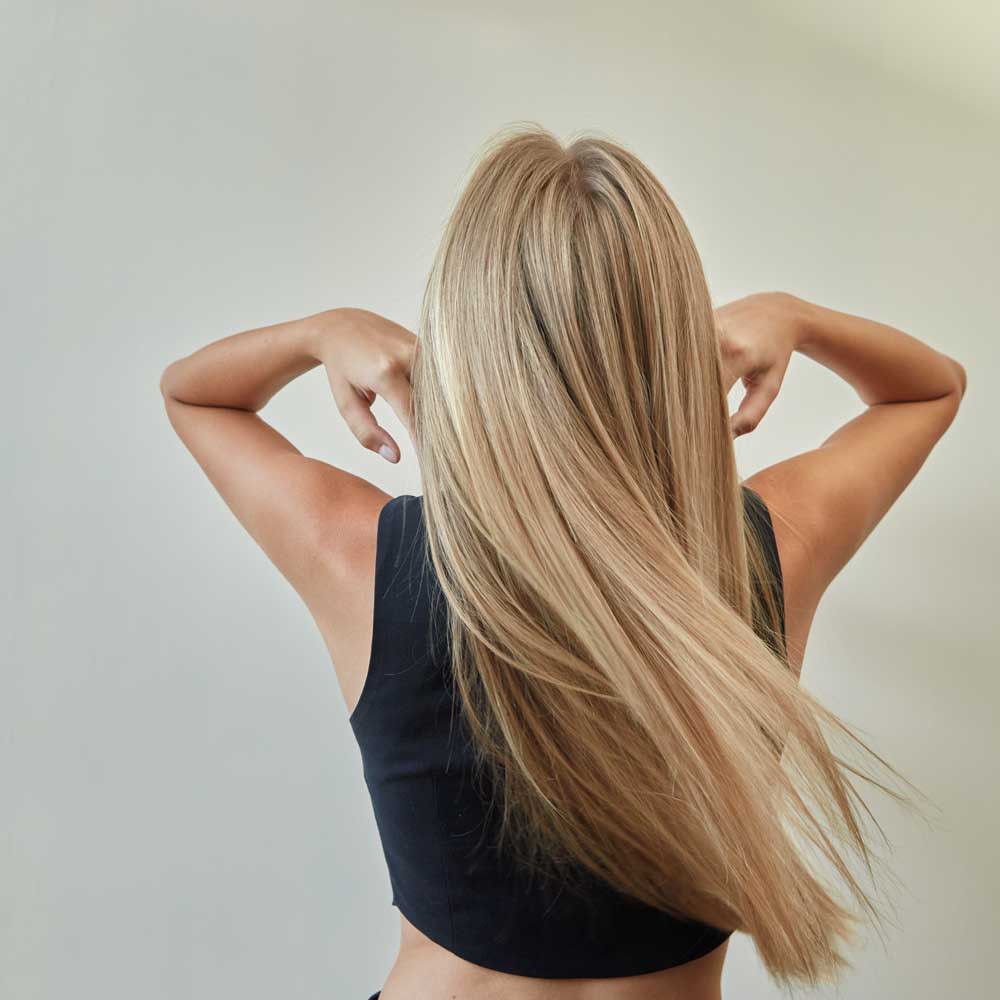
Uncover expert solutions on how to fix damaged bleached hair and restore its natural moisture and strength. Learn how to keep your colour vibrant and healthy, even after bleaching.
Going blonde, especially when starting with darker hair, can dramatically change your look — but it can also significantly impact your hair's health.
Bleaching, even to lighten just a few shades, can take its toll, often needing dedicated bleach damage repair. This process can leave hair cuticles compromised and weakened, leading to a dry, brittle texture. But don't worry, achieving your blonde ambition doesn't have to mean sacrificing your hair's health.
With the right care and attention, you can restore your hair's vitality. Keep in mind that one treatment will not be enough to totally treat bleached hair.
In this guide, we'll share expert tips, effective strategies, and the best treatments to help you rehydrate your hair after bleaching — featuring insights from Davines Regional Master Trainer Julia Tomczek. We'll help you keep your colour luminous and your hair feeling healthier and more hydrated.
The following expert tips and haircare treatments can help you begin to treat bleached hair and repair the damage.
Frequent shampooing can strip the cuticle of even more of the natural oils essential for healthy hair growth. If you can't face washing your hair without shampoo, explore our range of blonde hair products.
You'll find some of the best hydrating shampoos specifically formulated for bleached hair. Initially, aim to wash your hair every three to four days, using a shower cap on other days to protect it.
Gradually extend the time between washes by incorporating a high-quality dry shampoo into your routine. Consider a cleansing dry shampoo to add extra days between washes. This practice of 'hair training' can benefit both your hair and scalp health in the long term.
A must-have for anyone with blonde hair and a staple in every hairdresser's toolkit, a purple shampoo should be used every other week in place of your regular shampoo. Davines' Heart of Glass range is ideal for combating brassy tones.
Used both before and after showering, a nourishing hair oil can help hydrate and protect cuticles that have been roughened by the bleaching process.
By reducing friction, a key cause of hair damage, the oil helps prevent further harm in everyday life, not just during washing.
Julia emphasises the importance of hair oil for treating bleached hair: "Using a hair oil before and after shampooing can be a great way to lock in moisture.
Pre-treating your hair with oil before shampooing can create a buffer to your strands to keep the shampoo from stripping your hair. Using oil after you get out of the shower helps lock hydration in.
Oil creates a layer that moisture can’t escape. Bleached hair needs all the help it can get.
The first 3 weeks after bleaching are the most crucial so use that oil every day to repair the lack of that natural oil barrier."
Incorporating oil into your routine alongside your shampoo, conditioner, and hair mask will further lock in moisture and protect your strands from additional damage.
Using hot styling tools on bleached hair exposes already dry, vulnerable strands to further damage.
Applying a heat protectant spray, even on days when you're not heat styling, is highly advisable as it provides an extra layer of protection against everyday environmental damage.
While air-drying is the gentlest option for bleached hair, if you must use a hairdryer or other heated styling tools, it's essential to apply a protective blow-dry primer beforehand.
Your hairstylist will typically follow your initial bleaching session with a hair gloss treatment to seal and protect your colour, while also adding a healthy shine.
A hair gloss works by smoothing down roughened cuticles and filling in any gaps in the hair shaft. If your hair is looking dry and lacklustre, a gloss treatment can revitalise its appearance. Consider trying a rinse-out treatment for a salon-quality shine at home.
Keratin, a protein naturally found in hair, helps to seal the cuticles. This results in a shinier appearance. It also strengthens the hair fibres, helping to prevent split ends. If you're experiencing hair damage from bleaching, consider incorporating a keratin sealer into your regular haircare routine.
Here are a few simple lifestyle tweaks you can use to repair your bleached hair and add hydration back into your strands:
The solution to many beauty concerns is as simple as increasing your water intake. Make sure you're drinking enough water to hydrate your body from the inside out.
But how much fluid does the average, healthy adult living in a temperate climate actually need?
According to experts, an adequate daily fluid intake is approximately 3.7 litres for men and 2.7 litres for women.
Your diet plays a major role in the health of your hair. Biotin, collagen, and minerals are essential for strong, healthy hair.
When it comes to enhancing hydration, salmon is particularly beneficial. Rich in omega-3 fatty acids, protein, vitamin B12, and iron, it nourishes the scalp and promotes a healthy shine.
Blueberries and kale are also excellent additions to a hair-healthy diet, as they’re packed with antioxidants and vitamin B7.
Hot water can strip the moisture from your hair, so keep it lukewarm when you wash.
Finish with a blast of cold water when rinsing out your conditioner.
This seals your hair’s cuticles and the pores in your scalp, locking in moisture, and adding a boost of shine.

It's important to protect your fragile, dry strands while you sleep. A silk pillowcase is much gentler on hair than cotton pillowcases or hair scarves. Hair glides against silk preventing further damage on your hair follicles - while it clings to cotton.
This creates friction, leading to breakage. Plus, cotton sucks the moisture out of your hair leading to more dryness.
Regular trims are essential for maintaining healthy hair, especially after bleaching. By trimming away damaged ends, you prevent them from becoming excessively dry and brittle.
If left untrimmed, split ends can travel up the hair shaft, leading to further dryness and increased breakage. Baby hairs and fly-aways galore!
Find your nearest Davines salon here and book your next appointment today.
Balayage highlights are a lot gentler on your strands than all-over hair colour (and a lot easier to maintain). If your hair is dry, ask your stylist for balayage highlights instead of going fully blonde.
Whether you’ve just gone blonde and need a new hair care routine, or are just looking to hydrate overly-bleached strands, we’ve got you covered with everything you need to know about how to hydrate your hair after bleaching.
Explore our dedicated Blonde and Coloured haircare ranges to discover the full selection of Davines products designed to keep lighter hair vibrant, shiny, and optimally hydrated.
by Jaclyn LaBadia, featured contributor and expert beauty writer